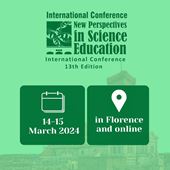Developing a Science-Club Programme based on Informal Learning Environments
Matthew Grech, University of Malta (Malta)
Charles Bonello, University of Malta (Malta)
Abstract
A great deal of science learning, often unacknowledged, takes place in out-of-school activities – in museums, libraries, nature centers, after-school programs, amateur science clubs, and even during conversations at the dinner table. Collectively, these kinds of settings are often referred to as informal learning environments. While there is no single definition of the term “informal learning”, the term tends to refer to “science learning that occurs outside the traditional, formal schooling realm . . .” . One of the goals of informal science environments is to introduce learners to scientific skills and concepts, the culture of science, and the role science plays in decision-making. Informal settings have an advantage in that they can reach people of all ages, with varying levels of interest and knowledge of science. They can support science learning and provide an insight into how science can be made meaningful to people of all ages, backgrounds, and cultures – a value long held dear in the informal science community . Previous studies have investigated the effects of out-of-school Science, Technology, Engineering and Mathematics (STEM) activities aimed at stimulating children’s interest in science with positive results. The aim of this study was to design and develop a series of science-related activities, experiments and resources aimed at stimulating young students’ interest in science in an informal learning environment effectively. The activities drew on a number of different internet-based resources including videos, documents, posters, images, and portals which were conducive to informal learning. Qualitative data in the form of an evaluative feedback form and individual interviews was generated from 8 science educators of varying backgrounds and experiences. The feedback generated, which included constructive criticism of each activity, their adaptability to school settings, their relevance to the school curriculum, and the practical and logistical issues associated with their organization, was utilised for the development of a science club programme that supported formal learning. In this way, it was hoped that students’ interest in science would be enhanced through such interactive and enjoyable out-of-school activities (i.e. an activity outside the realm of the traditional classroom), like a Science club, while ensuring that their engagement in the study of STEM subjects would be encouraged.
Keywords Informal learning environments, science learning, children’s interest, out-of-school activities.
References
• Dierking, L.D., Falk, J. H., Rennie, L. J., Anderson, D., & Ellenbogen, K.(2003). ‘Policy statement of the Informal Science Education ad hoc committee’, Journal of Research in Science Teaching, 40(2): 108–111.
• Fenichel, M., & Schweingruber, H. A. (2010). ‘Surrounded by Science: Learning Science in Informal Environments’, National Research Council of the National Academies, Washington, D. C.
• Walan, S. & Gericke, N. (2019). ‘Factors from informal learning contributing to the children’s interest in STEM – experiences from the out-of-school activity called Children’s University’, Department of Environmental and Life Sciences, Karlstad University, Karlstad, Sweden.
 New Perspectives in Science Education
New Perspectives in Science Education


























